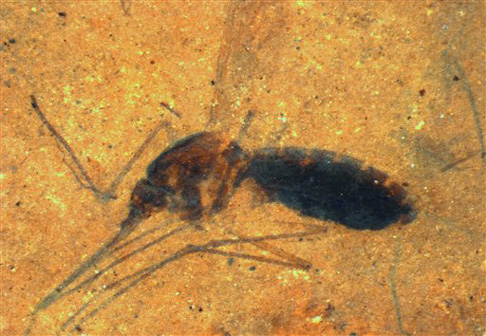A First for Biology – Blood Meal of an Insect Found Intact in a Fossil
In the steamy swamplands of what was to become the north-western part of the United States forty-six million years ago a tiny, insignificant event took place. An event which had been replicated in that area hundreds, perhaps thousands of times that day. A tiny mosquito used its needle-like proboscis to penetrate the skin of a vertebrate and took a meal of blood from its victim. Nothing remarkable about that you might say, but what happened next gave the opportunity for scientists to comment on this incident forty-six million years later.
Ancient Mosquito Fossil
The tiny midge, for some reason stalled in its flight over a body of water. Perhaps a sudden gust of wind forced the insect to crash land onto the surface of a pond. The mosquito quickly sank to the bottom, remarkably its body remained intact and it was quickly buried, preserving it and its distended abdomen filled with blood. The insect was fossilised and researchers exploring these Palaeogene deposits that now make up part of a mountainside in the state of Montana (USA), were able to view the tiny fossilised insect and postulate that the distended body contained the remains of its last meal.
A Window into the Past, The Preserved Mosquito Fossil
Picture credit: Smithsonian Institute/Dr Dale Greenwalt
Blood Preserved in Insects Trapped in Amber
It might sound like something that the author Michael Crichton would have written about. Mr Crichton wrote “Jurassic Park”, a story of the failed attempt to open a dinosaur theme park with the Dinosauria being resurrected by genetic manipulation of blood preserved in the bodies of insects trapped in amber. Fanciful stuff perhaps, but a paper in the academic journal “The Proceedings of the National Academy of Science” outlines the study of this beautifully preserved fossilised insect, potentially evidence of the oldest blood yet found in the fossil record.
For models and replicas of prehistoric invertebrates and other extinct creatures including dinosaurs: CollectA Age of Dinosaurs Popular Models.
Retired Dr Dale Greenwalt collects and studies insect fossils from the Montana deposits on behalf of the Smithsonian institute. The fossils, were discovered in fine grained shales that had been collected many years before and placed in storage. The female mosquito (only females feed on blood), had been trapped and nearby the remains of a second mosquito, this time most probably a male, was discovered. Using two different types of light-refracting x-rays that determine what chemicals are present along with advanced, non-destructive mass spectrometry analysis Dr Greenwalt and his colleagues determined that the female mosquito’s abdomen was full of iron, a major feature of blood that gets oxygen to the rest of the body.
Iron levels were higher than elsewhere in her body and no significant levels of iron were identified in the non-biting male mosquito fossil that was used as a control. The scientists also found evidence of porphyrins, organic compounds that play an important role in blood formation and helping to bind the iron within the blood. These two substances found together makes a “definitive case for blood” according to the researchers.
A “Definitive Case for Blood”
If this is proven to be true, the tests being verified, then this little mosquito preserves the oldest sample of blood known to science.
But where did the blood come from? Could it be a dinosaur? Sadly, most definitely not, the last of the Dinosauria became extinct some twenty million years before the mosquito hatched. The blood will have come from a vertebrate, most likely a bird according to Dr Greenwalt.
Dr Mary Schweitzer (North Carolina State University), a leader in the research to find microscopic soft tissues preserved in fossils, including the possibility of blood remnants associated with dinosaur fossils from the Hell Creek Formation of Montana, commented that whilst the study was exciting and significant, the research was in its preliminary phase and more work needs to be done to prove the conclusion by ruling out all other possibilities for the unexpected results showing iron concentrations and the possibility of other preserved organic compounds such as the suspected porphyrins.
Dr Greenwalt stated:
“The existence of this rare specimen extends the existence of blood-feeding behaviour in this family of insects 46 million years into the past.”
Blood feeding, otherwise known as haematophagy, occurs in approximately 14,000 living insect species including fleas, ticks and modern mosquitoes. These fossils are so well preserved that the scientists have been able to name them as two new species of insect. The female has been named Culiseta lemniscata, the male mosquito has been named as Culiseta kishenehn. Next time you get bitten by a midge, think on, that incident might, just might, lead to your blood being preserved for forty-six million years or so.






Leave A Comment